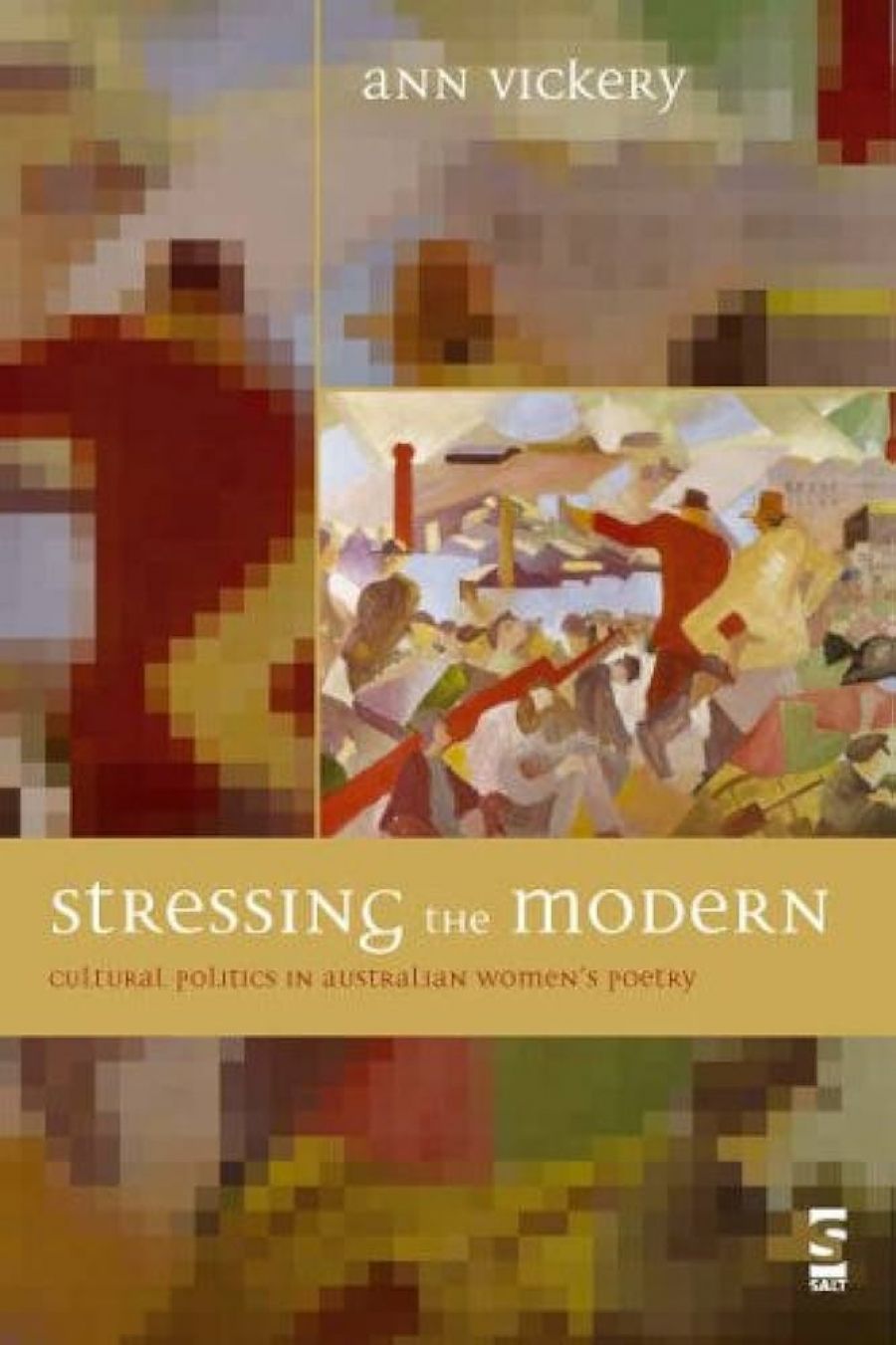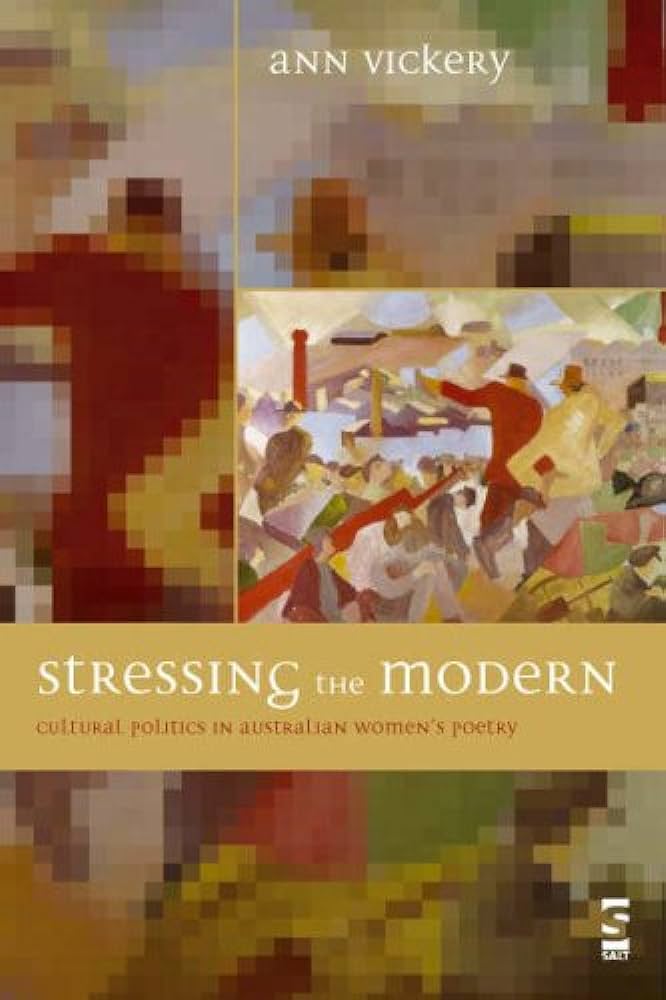
- Free Article: No
- Contents Category: Non-fiction
- Custom Article Title: Multiple modernisms
- Review Article: Yes
- Article Title: Multiple modernisms
- Online Only: No
- Custom Highlight Text:
I have commented before in ABR that literary criticism is a rara avis in Australia’s publishing world, so perhaps it is not surprising that Ann Vickery has had to find an overseas publisher for this important contribution to Australia’s literary and cultural history. Whatever its provenance, I have a particular reason for welcoming this contextualising study of the work and times of six women poets of the early twentieth century: Mary Gilmore, Marie Pitt, Mary Fullerton, Anna Wickham, Zora Cross, Lesbia Harford and Nettie Palmer.
- Book 1 Title: Stressing the Modern
- Book 1 Subtitle: Cultural politics in Australian women's poetry
- Book 1 Biblio: Salt, $59.95 pb, 320 pp
- Book 1 Cover Small (400 x 600):

- Book 1 Cover (800 x 1200):

Vickery respects her subjects, paying them the compliment of taking them seriously, as worthy of intelligent analysis of their lives and writing, rather than in need of overt sympathising. Her writing is calm rather than impassioned and, for the most part, unmarred by jargon. The substantial scholarly research that has gone into the making of her book is clear enough, but not ostentatiously displayed, being woven through her text with a judicious mixing of endnotes with paraphrases and direct quotation from secondary material. It is also offset by the generous amount of space given to examples of the poetry of each writer and to her own expository readings of these poems.
It is possible that readers less familiar than Vickery with the various theoretical accounts of modernism to which she refers may feel at times a need for definition of ‘modernism’ as a mode with its own technical and ideological characteristics. We can identify aspects of ‘the modern’ easily enough in terms of content and preoccupations: for instance, the subversion of the pieties of religion and history by doubt, the disruption of established ideas of gender roles posed by the ‘New Woman’, or the final triumph of industrialism, of the urban over the rural as the dominant site of human experience. We can also recognise how anti-modern Australian culture was in many ways, given the hold of ‘the bush’ as the defining locus of Australian identity and the strength of the valorising of the masculine in writers as influential, if different, as Henry Lawson, Kenneth Slessor, Norman Lindsay or indeed Vance Palmer.
Part of the modernity that Vickery identifies in her group of women poets is their varying engagements with cityscapes and city living, localised to Melbourne and Sydney factories and suburbs in Harford and Gilmore, cosmopolitan in Wickham and Fullerton, whose line ‘There was an awful silence once in Bloomsbury’ is perhaps the most overt allusion made by any of these women to English modernism. Yet Vickery show that Fullerton, bush-bred like Gilmore, shares – if to a lesser extent – Gilmore’s uneasy ambivalence towards the meaning of the figure of the Aborigine within a history of Australian settlement as heroic and benign.
One of the strengths of Vickery’s treatment is that she does not force similarities and connections between her six poets. Some of them she shows to have had direct and friendly contact with each other: Gilmore with Cross, or Harford with Palmer. Dwelling on these would be the mode of straightforward biography, which is not what Vickery is about. Rather, she shows all these women as connected by a social context which sometimes produces impersonal synchronicities of experience, as when Palmer in Paris, and Fullerton in London, are each reading, at much the same time, Edward Carpenter’s Love’s Coming of Age (1896) and The Art of Creation (1904). Those texts were part of the contemporary exploration of ‘female friendships’ that often skirted nervously around the word lesbianism. Vickery notes that Palmer embraced Carpenter’s idea of consciousness as evolving into an advanced soul that was human rather than specifically masculine or feminine, but did not ‘dwell’, as Fullerton did, on Carpenter’s connection between the advanced soul and homosexuality.
Ideas about the New Woman – her sexuality, her relationship to motherhood and domesticity, and her relationship to art – imposed considerable stress on the women of the early twentieth century. Among other things, it challenged them to re-articulate their subjectivity – something for which, Vickery argues, the writing of poetry was an important resource, especially since the modern period brought with it a new frankness in speaking about the intimacies of private life. And in confronting this stress in their writing (as each of these six poets did, if in different ways), the poets themselves put under stress not only traditional ways of seeing women, whether as women or as writers, but also on the aesthetics of modernism as conceived and defined by male critics and writers. There are ambiguities in Vickery’s title, as there are in the modernity of these poets. And for the reader to seek a single model of ‘modernism’, or to want to see writers ranked as its dominant or marginal exemplars, is indeed to miss the point of Vickery’s project as she defines it in her introduction: ‘How does Australian women’s poetry challenge received theories of modernism? How might new regional and gender-specific modernisms be generated through reading such poetry?’
It is an approach that reflects contemporary trends towards exploring and valuing multiple feminisms rather than contesting the high ground for one definitive form, and it produces a study that is richer in the cultural insights it offers than in analysis of how these poets exemplify the technical characteristics of modernism beyond occasional references to minimalism, imagistic effects and experimental verse forms, such as ‘In fitting with her modernist subject, Mary [Fullerton] writes in free verse’. Vickery goes on, however, to cite Fullerton as criticising modern poets for focusing too much on the technical at the expense of the natural and sensual. Vickery may have similar reservations about modern literary criticism as focusing too much on the technical.
One technical aspect that I wish an in-house editor had focused on a bit more is proofreading, especially within quoted poems. There are lapses that destroy sense in the passage cited when ‘Freedom’s’ emerges as ‘Freedom is’, ‘lest’ as ‘let’ and ‘like’ as ‘lie’ – and Catullus is definitely not Catallus. But I don’t want to finish on a minor discord. This is a big book, thoroughly researched, generous with information and ideas, and above all readable. I could have welcomed more after page 308 (where the text ends and the references begin). It’s hard to find a better readerly tribute than that.


Comments powered by CComment